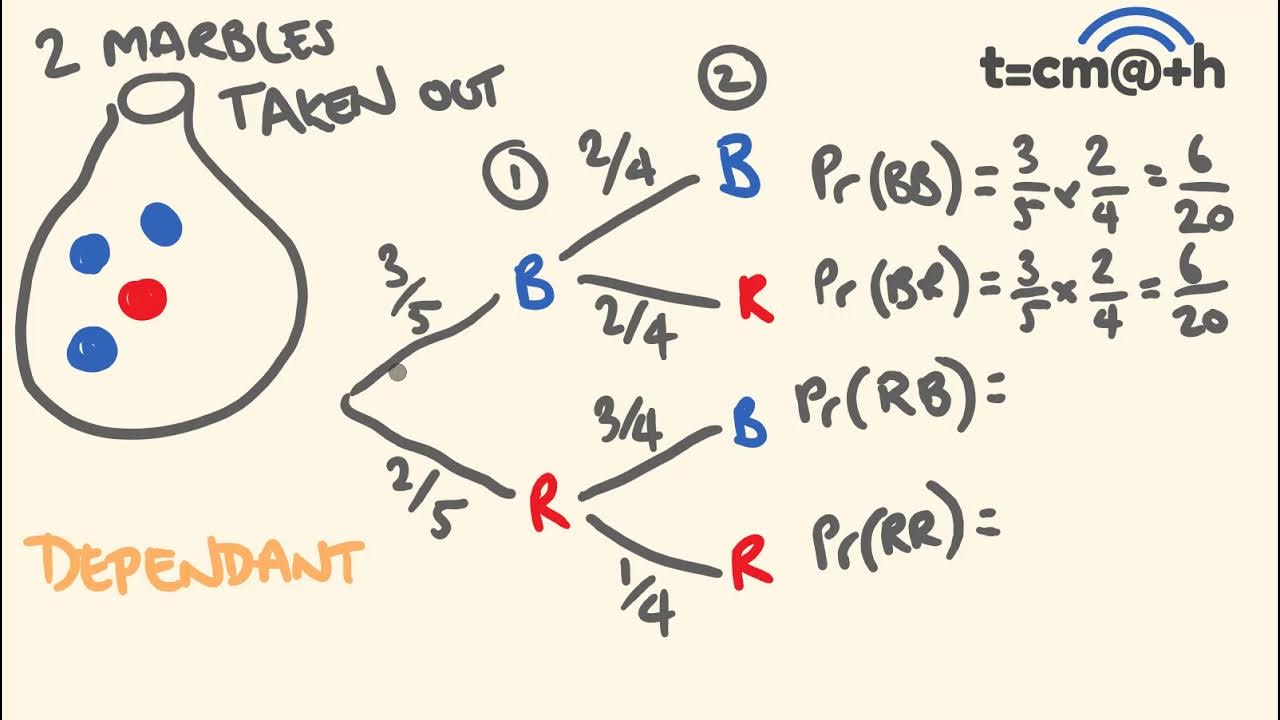Gr 11 Probability: Tree diagram
Summary
TLDRThis educational script explains the concept of tree diagrams in probability through a scenario where Kate draws marbles from a bag containing 3 orange and 7 blue marbles. It illustrates how to construct a tree diagram, calculate probabilities for different outcomes like drawing two oranges or two blues, and determine the chance of drawing at least one blue or orange marble. The script simplifies complex probability calculations by using the tree diagram method, making it accessible and engaging for learners.
Takeaways
- 🎲 Kate draws marbles from a bag containing 10 marbles, with 3 being orange and 7 being blue.
- 🌳 A tree diagram is used to visualize the probability of drawing different colored marbles, illustrating the process of drawing twice.
- 🔵 The probability of drawing a blue marble on the first draw is 7 out of 10, and it remains the same for the second draw due to replacement.
- 🟠 The probability of drawing an orange marble on the first draw is 3 out of 10, and it also remains the same for the second draw.
- 🍊 The probability of drawing two orange marbles is calculated by multiplying the probabilities of each individual draw (3/10 * 3/10 = 9/100).
- 🔵 The probability of drawing two blue marbles is found by multiplying the probabilities of drawing blue on both draws (7/10 * 7/10 = 49/100).
- 🤔 The probability of drawing at least one blue marble is calculated by adding the probabilities of all branches that include a blue marble (49/100 + 21/100 + 21/100 = 91/100).
- 🧩 A faster method to find the probability of drawing at least one blue is to subtract the probability of drawing no blue marbles from 1 (1 - 9/100 = 91/100).
- 🍊 The probability of drawing at least one orange marble is the sum of the probabilities of the branches that include at least one orange marble (21/100 + 9/100 = 51/100).
- 📊 Understanding the concept of 'and' and 'or' in probability is crucial; 'and' requires multiplication of probabilities, while 'or' requires addition.
Q & A
What is the total number of marbles in the bag according to the transcript?
-There are ten marbles in the bag, with three being orange and the rest being blue.
How does the process of drawing marbles with replacement work as described in the transcript?
-Kate draws one marble, records its color, puts it back into the bag, and then draws a second marble. This is called drawing with replacement because the first marble is returned to the bag before the second draw.
What is the probability of drawing a blue marble on the first draw?
-The probability of drawing a blue marble on the first draw is 7 out of 10, since there are seven blue marbles out of a total of ten.
What is the probability of drawing an orange marble on the second draw if the first marble drawn was blue?
-If the first marble drawn was blue and put back, the probability of drawing an orange marble on the second draw remains the same at 3 out of 10.
How is the tree diagram used to illustrate the probabilities of drawing marbles?
-The tree diagram is used to visualize the different outcomes and their probabilities for each draw. It branches out to show the possible combinations of drawing blue or orange marbles for each draw.
What is the probability of Kate drawing two orange marbles in a row?
-The probability of drawing two orange marbles in a row is calculated by multiplying the probability of drawing an orange marble on the first draw (3 out of 10) by the probability of drawing an orange marble on the second draw (also 3 out of 10), which equals 9 out of 100 or 0.09.
How is the probability of drawing two blue marbles calculated?
-The probability of drawing two blue marbles is calculated by multiplying the probability of drawing a blue marble on the first draw (7 out of 10) by the probability of drawing a blue marble on the second draw (7 out of 10), resulting in 49 out of 100 or 49%.
What is the significance of the term 'and' in calculating probabilities in the context of the transcript?
-In the context of the transcript, the term 'and' indicates that the probabilities of independent events should be multiplied together to find the probability of both events occurring.
How does the transcript suggest a faster way to calculate the probability of drawing at least one blue marble?
-The transcript suggests a faster way by calculating the probability of the complementary event (drawing two orange marbles) and then subtracting it from 1 to find the probability of drawing at least one blue marble.
What is the probability of Kate drawing at least one orange marble, and how is it calculated?
-The probability of drawing at least one orange marble is calculated by adding the probabilities of the branches that include at least one orange marble (blue-orange, orange-blue, and orange-orange), which equals 51 out of 100. Alternatively, it can be calculated by subtracting the probability of drawing two blue marbles (9 out of 100) from 1.
Outlines

This section is available to paid users only. Please upgrade to access this part.
Upgrade NowMindmap

This section is available to paid users only. Please upgrade to access this part.
Upgrade NowKeywords

This section is available to paid users only. Please upgrade to access this part.
Upgrade NowHighlights

This section is available to paid users only. Please upgrade to access this part.
Upgrade NowTranscripts

This section is available to paid users only. Please upgrade to access this part.
Upgrade NowBrowse More Related Video

Peluang | Matematika Kelas X SMA/SMK FASE E | Materi dan Latihan Soal

PELUANG - Kejadian saling lepas dan tidak saling lepas

Matematika Kelas 8 Bab 6 Peluang - Cara Menentukan Peluang - hal. 176 - 178 - Kurikulum Merdeka

Math Antics - Basic Probability

Materi dasar tentang peluang suatu kejadian. Matematika tingkat SMA & SMP

Probability - addition and multiplication rules
5.0 / 5 (0 votes)